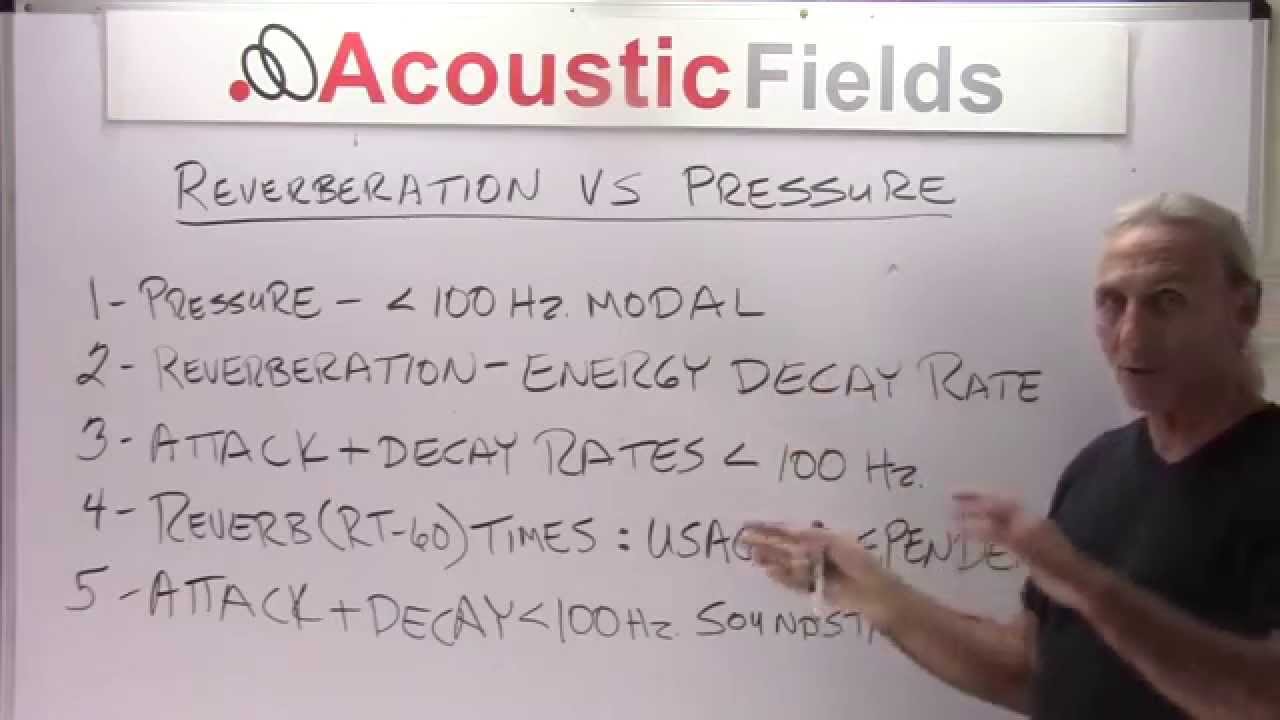The following is an unedited transcript from our video series from Acoustic Fields. There will be some errors in grammar and sentence structure that occur during this translation process.
For complete understanding and comprehension, please view the video which is included in this text. For any additional information regarding this topic or others relating to room acoustics, please contact us directly at:
P: 520 – 392 – 9486
dennis@acousticfields.com
______
Today we’re going to talk about reverberation and pressure in our rooms. So a lot of people get these issues confused. I hope some of these examples and definitions will help.
Pressure we all are familiar with, that’s all that unwanted base boom, low frequency booms, room modal issues. It’s always below a hundred cycles, that’s the area, kind of the dividing that we use because above a hundred cycles treatment is a lot easier than below a hundred cycles. Lot less square footage coverage, lot less density, lot less mass to treat those issues. So that’s how we define unwanted pressure issues.
Reverberation on the other hand is all that energy above that, that – mainly, I mean it does concern the lower frequencies but for purposes of discussion we’ll take the energy all above that, you know, that’s the time it takes for the energy to decay in the room. So we have pressure which is a build up most of the time of energy and then we have reverberation which is kind of the decay of energy. How long it takes the energy to get down to levels that we’ve already pre-determined.
So two different areas here we need to look at. Attack and decay rates also below a hundred cycles are critical in our rooms because that yields definition. A low-frequency note should have the same kind of definition, separation, clarity if you will that maybe not the highs but at least the mids have because they’re really related in the frequency spectrum. You need it tight to find low end in order for the mids to come through. It will give you a foundation. It just adds more dimension to the sound stage.
So the attack and decay rates below one hundred cycles in our rooms have to be managed correctly. Most of the products in the marketplace today cannot do that. They just don’t – they may have level but they don’t have the rate of absorption necessary to achieve this. So anybody can build an absorber that goes down to 40 Herz, getting it to absorb a lot of energy in a small amount of space is more difficult. So you keep that in mind when you’re looking at a product.
So our reverb times – what’s an ideal reverb time in our room? What’s an ideal time that we should use to manage all the reflections in our room and let that energy decay at a nice even rate? Usage dependent. We’re not going to get into number here because we can argue all day long. Let’s just put it this way. It’s dependent on the usage. A control room different than a live room. Live room different than a listening room. All room usages – home theater – a little bit different. So all of these usages have different reverb times that are acceptable highs and lows. What’s light between those is subjective. So you have to consider that also. So you have ranges and windows of acceptable times in the literature but really what it boils down to its personal preference. So dialing within the range and then fine-tune to personal preference.
Attack and decay rates below one hundred cycles if managed correctly in your room are really good for your sound stage. They really help fortify or poster all the things that you’ve done on your sound stage. So a company that subscribes to this philosophy is JL Audio and they do a really good job with producing a lot of energy in a small amount of space.
So attack and decay rates are definitely in the low end good for the sound stage if you get them right. Reverberation times for the middles and highs mostly but all of these things work together. So it’s reflections and pressure as always. Thank you. More to come.







